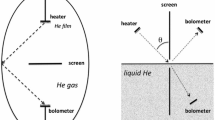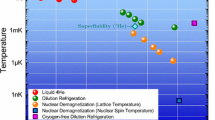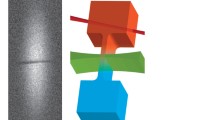Quantum evaporation is the evaporation of atoms from the surface of a liquid or solid by single excitations, such as phonons. We show that this process can only occur in systems for which the deBoer quantum parameter is above a critical value. For superfluid helium we argue that, because the interface between liquid and gas is not sharp, it may be useful to consider quantum evaporation as a process in which excitations coming from the liquid are adiabatically deformed as they propagate through the interface and then emerge as gas atoms. Based on this picture, we make several predictions which can be tested experimentally. Finally, we discuss quantum evaporation in solid hydrogen.
Similar content being viewed by others
References
See, for example, the discussion in J. Wilks, Liquid and Solid Helium (Oxford, London, 1967), chapter 20.
K. R. Atkins, B. Rosenbaum, and H. Seki, Phys. Rev. 113, 751 (1959).
D. V. Osborne, Proc. Phys. Soc. 80, 103 and 1343 (1962); G. H. Hunter and D. V. Osborne, Proc. Phys. Soc. Lond. 2, 2414 (1969); W. D. Kessler and D. V. Osborne, J. Phys. C. 13, 1571 (1980).
D. T. Meyer, H. Meyer, W. Halliday, and C. F. Kellers, Cryogenics 3, 150 (1963).
W. D. Johnston and J. G. King, Phys. Rev. Lett. 16, 1191 (1966).
K. Andres, R. C. Dynes, and V. Narayanamurti, Phys. Rev. A8, 2501 (1973).
S. Balibar, Phys. Lett. 51A, 455 (1975). See also the subsequent experiment by S. Balibar, J. Buechner, B. Castaing, C. Laroche, and A. Libchaber, Phys. Lett. 60A, 135 (1977).
M. J. Baird, F. R. Hope, and A. F. G. Wyatt, Nature 304, 305(1983).
F. R. Hope, M. J. Baird, and A. F. G. Wyatt, Phys. Rev. Lett. 52, 1528 (1984).
A. F. G. Wyatt, Physica 126B, 392 (1984).
M. Baird, B. Richards, and A. F. G. Wyatt, Jap. J. Appl. Phys. 263, 387 (1987).
M. Brown and A. F. G. Wyatt, Jap. J. Appl. Phys. 26–3, 385 (1987).
G. M. Wyborn and A. F. G. Wyatt, Jap. J. Appl. Phys. 26–3, 2095 (1987).
M. Brown and A. F. G. Wyatt, in Phonons 89, S. Hunklinger, W. Ludwig, and G. Weiss, eds. (World Scientific, Singapore, 1990), p. 1050.
M. Brown and A. F. G. Wyatt, in Phonons 89, S. Hunklinger, W. Ludwig, and G. Weiss, eds. (World Scientific, Singapore, 1990), p. 1053.
A. F. G. Wyatt, in Phonons 89, S. Hunklinger, W. Ludwig, and G. Weiss, eds. (World Scientific, Singapore, 1990), p. 1019.
G. M. Wyborn and A. F. G. Wyatt, Phys. Rev. Lett. 65, 345 (1990).
M. Brown and A. F. G. Wyatt, J. Phys. C: Cond. Matt. 2, 5025 (1990).
R. A. Cowley and A. D. B. Woods, Can. J. Phys. 49, 177 (1969).
J. Eckardt, D. O. Edwards, F. M. Gasparini, and S. Y. Shen, Proc. 13th Int. Conf. on Low Temperature Physics LT-13, K. D. Timmerhaus, W. J. O'Sullivan, and E. F. Hammel, eds. (Plenum, New York, 1973), p. 518.
D. O. Edwards, P. Fatouros, G. G. Ihas, P. Mrozinski, S. Y. Shen, F. M. Gasparini, and C. P. Tam, Phys. Rev. Lett. 34, 1153 (1975).
D. O. Edwards, P. P. Fatouros, G. G. Ihas, P. Mrozinski, S. Y. Shen, and C. P. Tam, in Quantum Statistics and the Many-Body Problem, S. B. Trickey, W. P. Kirk, and J. W. Duffym eds. (Plenum, New York, 1975), p. 175.
D. O. Edwards, G. G. Ihas, C. P. Tam, Phys. Rev. B 16, 3122 (1977).
V. V. Nayak, D. O. Edwards, and N. Masuhara, Phys. Rev. Lett. 50, 990 (1983).
S. Mukherjee, D. Candela, D. O. Edwards, and S. Kumar, Jap. J. Appl. Phys. 26–3, 257 (1987).
S. Mukherjee, D. O. Edwards, and S. Kumar, preprint.
A. Widom, Phys. Lett. 29A, 96(1969); D. S. Hyman, M. O. Scully, and A. Widom, Phys. Rev. 186, 231 (1969); P. W. Anderson, Phys. Lett. 29A, 563 (1969).
M. W. Cole, Phys. Rev. Lett. 28, 1622 (1972).
C. Caroli, B. Roulet, and D. Saint-James, Phys. Rev. B 13, 3875, 3884 (1976).
D. O. Edwards and P. P. Fatouros, Phys. Rev. B 17, 2147 (1978).
F. O. Goodman and N. Garcia, Phys. Rev. B 33, 4560 (1986).
P. M. Echenique and J. B. Pendry, Phys. Rev. Lett. 37, 561 (1976); J. Phys. C: Sol. State Phys. 9, 3183 (1976).
T. Usagawa, Phys. Lett. 73A, 339 (1979).
D. R. Swanson and D. O. Edwards, Phys. Rev. 37, 1539 (1988).
They point out that the calculated minimum time for the arrival of phonons is typically 5%; larger than the experimentally-measured value. This discrepancy is more than can be explained by the uncertainties in the experimental data or in the measurement of the phonon group velocity from the excitation dispersion curve.
C. Ebner and W. F. Saam, Phys. Rev. B 12, 923 (1975).
See, for example, L. D. Landau and I. M. Lifshitz, Quantum Mechanics (Pergamon, Oxford, 1965).
The momentum is in nearly all cases smaller on the gas side than in the liquid. A gas atom with momentum 0.1 »−1 has energy 0.06 K. Thus, for a gas atom of above this energy k min≥0.1»−1.
A. F. Andreev, Sov. Phys.-JETP 19, 1228 (1964).
M. Nielsen, Phys. Rev. B 7, 1626 (1973).
This is obtained in Ref. 40 by constructing a lattice-dynamical model that fits the neutron scattering data. The highest energy phonon mode is not directly measured in the experiment.
See, for example, P. C. Souers, Hydrogen Properties for Fusion Energy (University of California, Berkeley, 1986), p. 112.
Strictly, this remark is incorrect for a crystal which is in its lowest energy state at very low temperatures. Such a crystal would have atomically-smooth facetted surfaces, and the energy to remove any atom (except a very small number on the edges or corners) would be the same. This energy would be larger than the average binding energy per molecule. After one atom was removed from a facet the crystal could, in principle, rearrange itself into a state of lower energy in which its surface was again entirely made up of facets without missing atoms. We are assuming that this rearrangement takes a very long time and can be neglected. Then for a crystal undergoing quantum evaporation in a continuous way surface atoms inevitably exist in a variety of configurations.
C. Delalande and G. M. Gale, Chem. Phys. Lett. 50, 339 (1977).
Author information
Authors and Affiliations
Rights and permissions
About this article
Cite this article
Maris, H.J. Quantum evaporation from quantum liquids and solids. J Low Temp Phys 87, 773–792 (1992). https://doi.org/10.1007/BF00118334
Received:
Revised:
Issue Date:
DOI: https://doi.org/10.1007/BF00118334




